Cervical sampling with the SZALAY CYTO-SPATULA
The possibilities of
minimizing the number of false-negative results with the Szalay Cyto-Spatula
The
most frequent causes of false negative smears are:
-
From
the clinical specialist's viewpoint:
Insufficient
cervical sampling (approx. 30% insufficient smears with the cotton swab).
-
From
the cytologist's viewpoint:
Negative
result (Pap 1 or 2) of a positive case owing to inadequate smear.
-
From
the biological side:
a)
ENDOCERVICAL ABNORMALITIES: The
squamo-columnar junction, which plays such a seminal role in the genesis of
cervical carcinoma, is often relocated in the canal. Therefore fifteen to
twenty per cent of intraepithelial lesions are found in the endocervix.
Neither the colposcope, nor the traditional methods of cytologic sampling,
ensure their early and accurate detection.
b)
SUPERFICIAL EPITHELIAL CHANGES WHICH
HINDER REPRESENTATIVE SAMPLING:
Traditional cytologic sampling results in smears composed of cells which
have exfoliated from the most superficial layer of the epithelium. In some
cases of high grade squamous intraepithelial lesion and invasive carcinoma
special stains (Krutsay) reveal superficial keratinisation which on occasion
may form thick hyperkeratotic plaques. These not only prevent the
spontaneous exfoliation of underlying neoplastic cells, but also form
impermeable barriers for the cotton-tipped applicator, so that procuring of
neoplastic cells becomes impossible. The metabolic exchange and blood supply
of the superficial portion of invasive carcinomas are precarious. This
results in extensive cellular degeneration and necrosis. The covering
necrotic blanket makes the deeper lying neoplastic cells unavailable for
examination. Hence the relatively frequent false negative smears in cases of
invasive carcinoma (20-25%).
Print
or download the sample taking technique using the SZALAY CYTO-Spatula (PDF file)
(short form)
Smear taking technique
presentation (detailed)
|
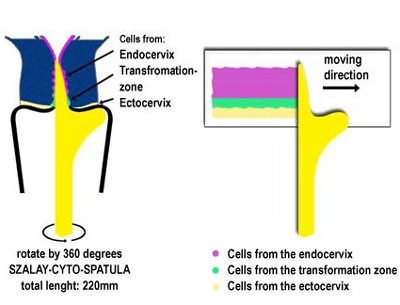
|
A conventional Pap test (Papanicolaou) made with the SZALAY CYTO-SPATULA
provides most reliable results, because with correct application always
sufficiently well preserved and representative cell material is
obtained. Medical
opinion is that the SZALAY-CYTO-SPATULA improves the quality of smears
and significantly reduces the number of false negative
smears. |
| 1 |
Label
the slide on the ground-glass side using a pencil (sequence number or name
of patient). |
|
|
| 2 |
After
insertion of the speculum the surface of the ectocervix is cleansed with a
cotton swab and any mucus and debris removed. |
|
 |
| 3 |
The
Spatula with the optimal shape and size is chosen from the
series. |
|
|
| 4 |
The
'tongue' of the spatula is introduced into the canal, whilst its 'shoulder'
is positioned on the 3 o'clock position of the ectocervix at the beginning
of the procedure. |
|
|
| 5 |
With
gentle pressure the spatula is rotated
in a clockwise direction (see VideoClip).
If the cervical canal is wide the spatula is allowed to wander according to the contour of the cervix
during rotation. If after rotation through 360° without bleeding (see
important information) it is felt that sampling is inadequate, the
procedure may be repeated one or two times. |
|
 |
| 6 |
The
cells are spread on the slide always along its long axis, parallel to its
edges. If the distribution of the cellular material is uneven, the same
spatula may be used for respreading. |
|
 |
| 7 |
The
slide is immediately fixed. A
distance of about 30 cm should be kept to prevent the cell sample from being
blown away. |
|
|
| 8 |
Once
the slide has been fixed, place the slide inside the envelope for dispatch. |
|
|
| 9 |
The optimal date for taking a smear is in the middle of the menstrual
cycle. An unfavourable date for taking a smear may result in unnecessary
bleedings.
|
|
|
| 10 |
The
Szalay Cyto-Spatulas are discarded after use. They may be burned as they
leave no residue. |
|
|
LOCATING
LESIONS FROM THE SMEAR
-
Endocervical
lesions: Abnormal cells taking up a
position on the upper portion of the slide are assumed to derive from the
tongue of the spatula.
-
Ectocervical
lesions: Abnormal cells which are found
on the lower third of the smear represent those obtained by the shoulder of
the spatula.
-
Ecto-endocervical lesions:
Even distribution of abnormal
cells throughout the slide reflects simultaneous ecto- and endocervical
disease.
|
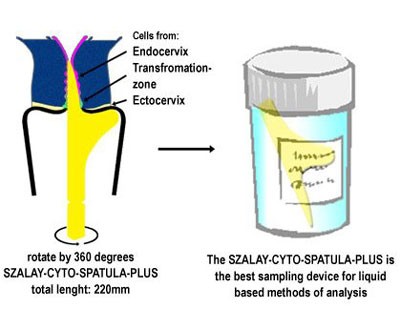
|
A
smear taken with the SZALAY CYTO-SPATULA provides highly reliable
results for both conventional (Papanicolaou)
and the newer very expensive but not really
better liquid-based (Cell Suspension Based Cytologic) methods of analysis. A conventional Pap test (Papanicolaou) made with the SZALAY CYTO-SPATULA
provides most reliable results, because with correct application always
sufficiently well preserved and representative cell material is
obtained. Medical
opinion is that the SZALAY-CYTO-SPATULA improves the quality of smears
and significantly reduces the number of false negative
smears. |
If
the smear is to be further processed with liquid based (Cell Suspension Based
Cytologic) methods of analysis, the head of the SZALAY CYTO-SPATULA Plus is
removed after cervical sampling (item 5 above) by breaking it off at the visible
score line, and sealed in a designated container with the special solution for
further processing.
Print
or download the range of shape and size of spatula (PDF file)
|

|
|

|
|

|
|

|
| Real
size of the Szalay Cyto-Spatula is: Device-lenght=220mm; Device-width:
5mm |
|
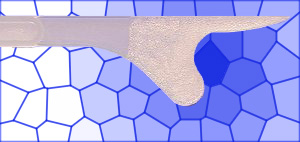
|
Szalay
Cyto-Spatula No. 1
(for a small through medium sized portio) |
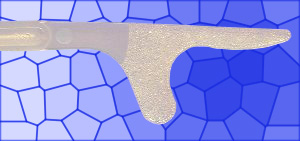 |
Szalay
Cyto-Spatula No. 2
(for a medium to large sized portio) |
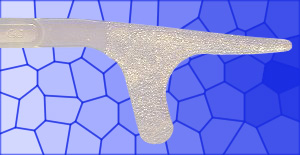 |
Szalay
Cyto-Spatula No. 3
(for a very large portio) |
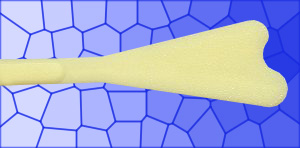 |
Szalay
Cyto-Spatula No. 4
a) for a larger cervix with an extended transformation zone, in
addition to a cervical smear with a No. 1, No. 2 or No. 3
spatula or in combination with a Cytobrush.
b) for a smear from the outer surface only, in patients with an
obliterated cervical canal or one that is too narrow for the
passage of a No. 1 spatula. The cytology laboratory must be
informed if this is the case. |
|
The
images above are bigger than the actual size of the
Szalay-Cyto-Spatula |
The
smear taking technique is documented in the following small video clip. It can
be obtained by download directly or can be ordered on a CD by email
to CSM Graf GmbH.
|
Requirements:
To play the clip, you need Windows Media Player which comes as a standard
feature with Windows. You may need to update the version installed on your
PC to the latest version. If you are connected to the internet, the update
usually takes place automatically as soon as you play the clip.
Downloading the clip as a
.wmv file:
Using the mouse, right-click the right link and store the file on your PC.
Then execute it on your PC by double-clicking.
Playing directly from this side:
If you have a high-speed internet connection, you may play the clip
directly by double-clicking the right link. |
Video Clip
on
smear technique
(Windows Media File, ca. 12. MBytes, Version: June 2008) |
In
approximately 2-3% of cases, slight bleeding may occur when taking the cervical
sample. This does not affect the colposcopic examination. Slight spotting may
occur in that case for one to two days. This
should cause no problem if the patient is informed of this possibility. Only
very rarely does the blood affect the
cytologic assessment. The colposcopic examination may also be conducted prior to taking the
cervical sample.
Home
breast test, cancer, pap, health, obgyn,
pap smear, pap test, women's health, women's healthcare, women's cancers, annual exam, pelvic exam,
gynecology exam, cervical cancer, gynecology, gynecologist, gynecological, cytology, oncology,
papanicolaou, cervical screening, health insurance, HPV, human papilloma virus, cervical smear,
STDs, sexually transmitted diseases ayre csm graf
liquid based szalay cyto spatula obwegeser plus acta cytologica spatula zytologie gynäkologie
abstrich abstrichentnahme abstrichqualität abstrichtechnik beschwerden brush carcinoma
carcinoma in situ cervikal cervix cervix uteri cervixkrebs collumcarcinom curettage cyto spatula
cytobrush cytospatel cytospatula detritus dysplasie ectocervix ektopie
dünnfilm technik ektozervikale veränderungen ektozervix endocervix endometrium endozervikal
endozervikale veränderungen endozervix endozervixzellen entnahmetechnik epithel
epitheltyp exfoliation falsch-negativ frauen frauenarzt frauenbeschwerden
granulozyten gynäkologie gynaecology gynecology gynaekozytologie hiv hpv
intraepithelialen intrazervikal invasiv kolposkop kolposkopie konisation krebs
krebsrate krebsvorsorge krebszellen kunststoffspatel labraskopie laparatomie läsion malignität
menses metaplasiezellen muttermund nekrose neoplasie neurotisch oestrogen
oestrogenapplikation paranekrose plattenepithel plastikspatel plattenepithelkarzinom
plattenepithelzellen portio portiokarzinom proliferationsphase qualität
routineabstrich schleim screening situ speculum spekulum sterblichkeit
strichcurettage szalay spatel szalay cyto spatula transformationszone unterleib
unterleibskrebs uteri vorsorgeuntersuchung zelldiagnostik zellen zervikalkanal
zervix zervix uteri zervixkarzinom zervixkrebs zervixschleim zervixzytologie
zylinderepithel zytodiagnostik zytodiagnostik zytologe zytologie zytotechnik csm
graf ayre bethesda biopsy cervexbrush cancer carcinoma carcinoma in situ cell cell
diagnosis cervical carcinoma cervix uteri colposcopy cyto cyto spatula cytologic
samples cytologic sampling cytology cytology of the uterine diagnosis ectocervix
endocervical abnormalities endocervix epithel false negative smear
false-negative health instrument necrosis parakeratosis smear smear taking smear
taking instrument smear taking technique smear taking tool pap smaera device smears spatula system
take a smear tool transformation zone uterine uterine cytology carcinome cellule
col utérin cytologie dépistage dysplasie éctocervix endocervix frotti frottis frotis
cytologiques gynécologie gynécologue hiv hpv utérin dépistage cytologique espátula plástico
www.yahoo.com www.altavista.com www.dogpile.com












